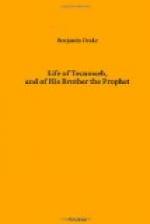McDonald, in speaking of this action, says:
“The celebrated Tecumseh commanded the Indians. His cautious and fearless intrepidity made him a host wherever he went. In military tactics, night attacks are not allowable, except in cases like this, when the assailing party are far inferior in numbers. Sometimes in night attacks, panics and confusion are created in the attacked party, which may render them a prey to inferior numbers. Kenton trusted to something like this on the present occasion, but was disappointed; for when Tecumseh was present, his influence over the minds of his followers infused that confidence in his tact and intrepidity, that they could only be defeated by force of numbers.”
Some time in the spring of 1793, Tecumseh and a few of his followers, while hunting in the Scioto valley on the waters of Paint creek, were unexpectedly attacked by a party of white men from Mason county, Kentucky. The circumstances which led to this skirmish were the following. Early in the spring of this year, an express reached the settlement in Mason, that some stations had been attacked and captured on Slate creek, in Bath county, Kentucky, and that the Indians were returning with their prisoners to Ohio. A party of thirty-three men was immediately raised to cut off their retreat. These were divided into three companies, of ten men each;—Simon Kenton commanding one,—Baker another, and James Ward the third. The whole party crossed the Ohio river at Limestone, and aimed to strike the Scioto above the mouth of Paint creek. After crossing this latter stream, near where the great road from Maysville to Chillicothe now crosses it, evening came on, and they halted for the night. In a short time they heard a noise, and a little examination disclosed to them that they were in the immediate vicinity of an Indian encampment. Their horses were promptly taken back some distance and tied, to prevent an alarm. A council was held,—captain Baker offered to go and reconnoitre, which being agreed to, he took one of his company and made the examination. He found the Indians encamped on the bank of the creek, their horses being between them and the camp of the whites. After Baker’s report was made, the party determined to remain where they were until near daylight the next morning; and then to make an attack in the following manner. Captain Baker and his men were to march round and take a position on the bank of the stream, in front of the Indian camp: captain Ward was to occupy the ground in the rear; and captain Kenton one side, while the river presented a barrier on the fourth, thus guarding against a retreat of the Indians. It was further agreed that the attack was not to commence until there was light enough to shoot with accuracy. Before Kenton and Ward had reached the positions they were respectively to occupy, the bark of a dog in the Indian camp was heard, and then the report of a gun. Upon this alarm, Baker’s men instantly fired, and captains Kenton




